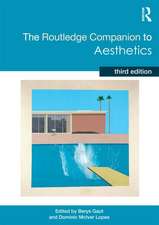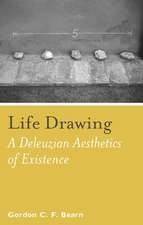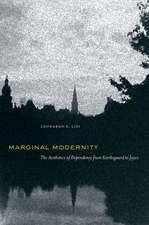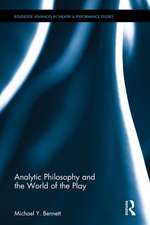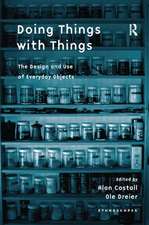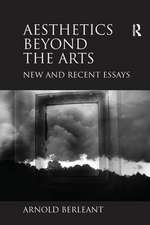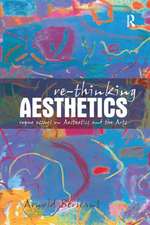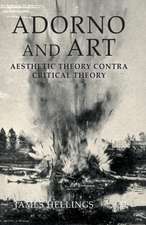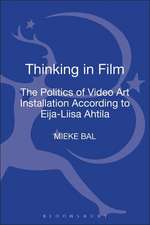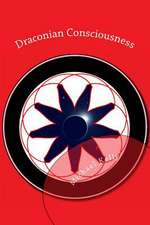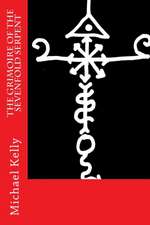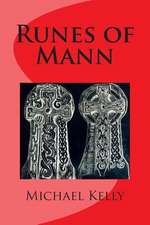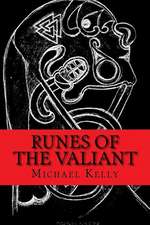Black Art and Aesthetics: Relationalities, Interiorities, Reckonings
Editat de Michael Kelly, Prof Monique Roelofsen Limba Engleză Paperback – 27 dec 2023
| Toate formatele și edițiile | Preț | Express |
|---|---|---|
| Paperback (1) | 172.95 lei 3-5 săpt. | +41.07 lei 7-13 zile |
| Bloomsbury Publishing – 27 dec 2023 | 172.95 lei 3-5 săpt. | +41.07 lei 7-13 zile |
| Hardback (1) | 414.16 lei 6-8 săpt. | |
| Bloomsbury Publishing – 27 dec 2023 | 414.16 lei 6-8 săpt. |
Preț: 172.95 lei
Preț vechi: 183.33 lei
-6% Nou
Puncte Express: 259
Preț estimativ în valută:
33.10€ • 34.51$ • 27.51£
33.10€ • 34.51$ • 27.51£
Carte disponibilă
Livrare economică 27 februarie-13 martie
Livrare express 13-19 februarie pentru 51.06 lei
Preluare comenzi: 021 569.72.76
Specificații
ISBN-13: 9781350294622
ISBN-10: 1350294624
Pagini: 400
Dimensiuni: 169 x 244 x 25 mm
Greutate: 0.7 kg
Editura: Bloomsbury Publishing
Colecția Bloomsbury Academic
Locul publicării:London, United Kingdom
ISBN-10: 1350294624
Pagini: 400
Dimensiuni: 169 x 244 x 25 mm
Greutate: 0.7 kg
Editura: Bloomsbury Publishing
Colecția Bloomsbury Academic
Locul publicării:London, United Kingdom
Caracteristici
Features essays, poetry, interviews and images from a wide range of disciplines including cultural studies, art history, black studies, philosophy, feminism, history, and sexuality studies
Notă biografică
Michael Kelly is Professor of Philosophy at the University of North Carolina at Charlotte, USA. He is President of the Transdisciplinary Aesthetics Foundation, editor of the Encyclopedia of Aesthetics (2014, 2nd edition), and author of A Hunger for Aesthetics: Enacting the Demands of Art (2017). Monique Roelofs is Professor of Philosophy of Art and Culture at the University of Amsterdam, the Netherlands. She is the author of The Cultural Promise of the Aesthetic (2014) and Arts of Address: Being Alive to Language and the World (2020).
Cuprins
List of IllustrationsAcknowledgmentsPreface: Blackness, Whiteness, and Curatorial Care, Michael Kelly (University of North Carolina at Charlotte, USA) and Monique Roelofs (University of Amsterdam, the Netherlands)Introduction: Revalorizing Black Aesthetics, Michael Kelly (University of North Carolina at Charlotte, USA) and Monique Roelofs (University of Amsterdam, the Netherlands) PART I. Blackness as Aesthetic Strategy 1. Coloring History, Theory, and Painting, Meleko Mokgosi (Artist, Yale University, USA) 2. From the new black and from semiautomatic, Evie Shockley (Poet and Theorist, Rutgers University, USA) 3. Art and Negative Dialectics: On Soft Aesthetics, Angela Y. Davis (UC Santa Cruz, USA) 4. Embracing Injury: Black Queer Bodies and Poetic Experimentation, GerShun Avilez (University of Maryland, USA) 5. Afrodiasporic Aesthetics in Classical and Experimental Music After 1960, George E. Lewis (Musician and Theorist, Columbia University, USA) PART II. Black Art Spaces 6. See Me Here: Defining Black Space at the Intersection of Artistic and Curatorial Practices in Privy, Deborah Goffe (Dancer and Theorist, Trinity College, USA) 7. The Black Image Corporation: When History Isn't Enough. The Need for Corporate Practices Within the Archive, Theaster Gates (Artist, Chicago, USA) 8. elevators, Simone White and Benjamin Krusling (Poets, University of Pennsylvania and New York City, USA) 9. Aesthetic Form in the New Thing: Aesthetic Sociality of Musique Informelle, Fumi Okiji (Musician and Theorist, University of California, Berkeley, USA) 10. White by Design, Mabel O. Wilson (Architect and Theorist, Columbia University, USA) PART III. History Making 11. Swampy Land by the River Don, Nell Painter (Artist and Historian, Princeton University, USA) 12. Addressing the World? Aesthetics of Resistance, Difference, and Relationality in Aimé Césaire's Plays, Mickaella Perina (University of Massachusetts at Boston, USA) 13. Making Histories: Wangechi Mutu in Conversation with Isaac Julien and Claudia Schmuckli, Wangechi Mutu (Artist, New York City, USA); Isaac Julien (Filmmaker, London and UC Santa Cruz, USA); and Claudia Schmuckli (Curator, Fine Arts Museums of San Francisco, USA) 14. Aliveness and Aesthetics, Kevin Quashie (Brown University, USA) 15. Two Images: Fons Americanum and The Right Side, Kara Walker (Artist, New York City, USA) PART IV. Groundings, Transpositions, Breaks 16. From the black maria and from Kingdom Animalia, Aracelis Girmay (Poet, Stanford University, USA) 17. Groundwork: Race and Aesthetics in the Era of Stand Your Ground Law, Sarah Elizabeth Lewis (Harvard University, USA) 18. "Survival is not a theory": Afro-Pessimism Transposed, Paul C. Taylor (University of California, Los Angeles, USA) 19. Imitation of Life/A Box Full of Darkness, James B. Haile, III (University of Rhode Island, USA) PART V. Callings 20. Tracy K. Smith's Ordinary Life: Enfleshing a Theory of Post-Soul, Daphne Lamothe (Smith College, USA) 21. From Citizen and from Don't Let Me Be Lonely, Claudia Rankine (Poet, New York University, USA) 22. Dance On, Thomas F. DeFrantz (Dancer and Theorist, Northwestern University, USA) 23. 'One-eyed' Immersive Particularities, Jeremy Matthew Glick (Hunter College, USA) 24. On Black Speculative Musicalities, Vijay Iyer (Musician and Theorist, Harvard University, USA) Index
Recenzii
Black Art and Aesthetics is an important collection of cutting-edge essays that explore the possibility of "revalorizing" Black aesthetics in ways that embrace both complex continuities and ruptures in the freighted history of aesthetics. The volume assembles writing by some of the most innovative artists and thinkers at the core of black contemporary art history, criticism and practice.
This impressive and vibrant assemblage of artists, poets, and theorists showcases the beauty and brilliance of Black aesthetics. Each investigation buzzes with strategies for creating, living, and being despite difficulty. As a gathering, Black Art and Aesthetics promises to remake how we see the world.
The essays collected in Black Art and Aesthetics represent a comprehensive statement on the continuing vitality of Black aesthetics and a revaluation of the cultural forces that have been driving the production of art in the Black diaspora. Drawing from a gallery of distinguished scholars, poets, and artists, this volume will serve as a model of critical thinking about Black aesthetics for a long time.
Finally, we have a book that explores and tracks the fugitive, complicated, intractable, and vital idea of Black Aesthetics with the expansive critical and intellectual sophistication that the scholarship has been waiting for since the 1960s. Finally.
Now that this wonderful anthology of Black Art and aesthetics is finally here, we can see just how necessary and long-awaited it was. And it's not just a juxtaposition of texts and works of art in a still tableau. It is, fortunately, a powerful expression of the movement and life force of the inexhaustible fountain of black aesthetics: fons africanus and fons americanus all at once.
Kelly and Roelofs's collection is a welcome and much needed contribution to the philosophically-informed study of Black Art and aesthetic practices. The range of insight is impressive and the acuity of the analyses even more so. Artists and theorists alike will draw inspiration from these essays.
This impressive and vibrant assemblage of artists, poets, and theorists showcases the beauty and brilliance of Black aesthetics. Each investigation buzzes with strategies for creating, living, and being despite difficulty. As a gathering, Black Art and Aesthetics promises to remake how we see the world.
The essays collected in Black Art and Aesthetics represent a comprehensive statement on the continuing vitality of Black aesthetics and a revaluation of the cultural forces that have been driving the production of art in the Black diaspora. Drawing from a gallery of distinguished scholars, poets, and artists, this volume will serve as a model of critical thinking about Black aesthetics for a long time.
Finally, we have a book that explores and tracks the fugitive, complicated, intractable, and vital idea of Black Aesthetics with the expansive critical and intellectual sophistication that the scholarship has been waiting for since the 1960s. Finally.
Now that this wonderful anthology of Black Art and aesthetics is finally here, we can see just how necessary and long-awaited it was. And it's not just a juxtaposition of texts and works of art in a still tableau. It is, fortunately, a powerful expression of the movement and life force of the inexhaustible fountain of black aesthetics: fons africanus and fons americanus all at once.
Kelly and Roelofs's collection is a welcome and much needed contribution to the philosophically-informed study of Black Art and aesthetic practices. The range of insight is impressive and the acuity of the analyses even more so. Artists and theorists alike will draw inspiration from these essays.

